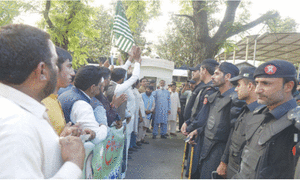
HARIPUR: “I was barely 10 years old when I took up the chisel and hammer and started scrabbling around the surface of black stone slate aiming to copy my father who was engrossed in carving a sword’s image on a similar piece of stone that was originally a tombstone,” says Haji Munsif Khan, a 73-year-old artisan who claims to be from a family that has conserved and promoted the 3,000 years old art of black stone carving in Haripur district.
He said it was an ineradicable memory as the carelessly small effort then earned him encouragement from his father, who himself had inherited the art of being a craftsperson from his father.
Hailing from the Pashto-speaking Gadwalian village, Haji Munsif Khan told Dawn that his late father would make him sit and observe what he would be doing with chisel and hammer on the stone surface.
He said that since forefathers his family had been in the profession of shaping and carving inscriptions on the gravestones, locally known as black stone having resemblance with black marble which was available in Gandgar hills of Sirikot in the district.
73-year-old Haji Munsif says he has inherited the art from his father
Sharing the memories of his early days of being a “forced disciple” of his father, Mr Khan said constant motivation from his father helped him develop mastery to the extent that he started sharing the workload of his father.
About the most popular designs that his clients used to order six decades back, he said there were two black stones each measuring 2.5 to 3ft wide and 3 to 4ft high as headstoneinstalled on the head side and the one erectedat the tail end of the grave.
“There used to be uniqueness attached to the two stones: the head side tombstone of woman’s grave carried the inscription of images of earrings, necklace and some flowers, while the tail side stone used to be inscribed with a qooza (water carrying utensil like lota used for ablution in mosques), Quranic verses and a prayer mate,” he said.
Whereas the men’s gravestone erected on the head side used to be engraved with identity, the date of birth and death and swords or daggers on the sides and some Quranic verses while the tail-end stone had a qooza and prayer mate and some floral images.
“But over the years the trends have changed altogether. People prefer to carve the names of women deceased, get different Quranic verses engraved with images, pave the graves with black stone slates against the old trend of leaving the graves unpaved with only two identity plaques erected,” he said.
Answering a question, he said that for preparing a full size or adult’sgrave with black stone he had to spend eight days with over 12 hours labour daily for carving identity, Quranic verses and floral images of different size and design.
About the charges, he said that the price depends on the size and height of the grave. The grave with 17 inches height is prepared for Rs22,000, 15 inches height for Rs 20,000 and 14 inches height Rs16,000. He said that double rate was charged for the grave with two-step height.
Answering a question, he said he still took the raw slates, extracted from the mines of Kali Gali village, for cutting and shaping into required sizes for gravestones to the city area as there was no facility of cutter machines in his area.
Mr Khan said that courtesy automation his designing work had become easy.
However, he said there was a big difference between handmade and machine-made graves. He said that people still liked handmade graves.
Answering a question, he said his younger brother, a nephew and son were engaged in keeping this centuries-old carving art alive.
He said that his younger brother also engraved face sculptures and had in the past carved the portrait of Nelson Mandela and some other personalities on the black stone.
Published in Dawn, August 4th, 2020












































